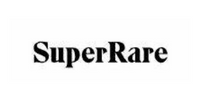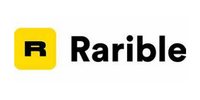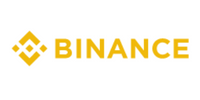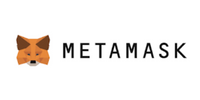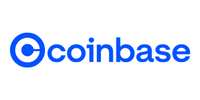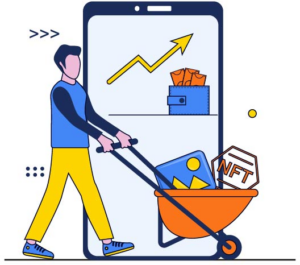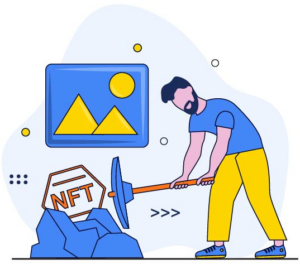NFTs have taken over the world over the past few years, so it’s only logical that many investors are looking for the NFT meaning all over the internet.
The following page will cover everything related to NFTs, how they work, and how you can invest in them through different channels. If you’re interested in the fantastic world of NFTs, keep reading!
As its name implies, an NFT is a token; specifically, a cryptographic token. These assets are located on the “Blockchain” network, which is a digital ledger, and they include unique metadata/identification coding. Overall, people can buy, sell, or trade NFTs through different marketplaces.
The thing that makes NFTs different from any other assets is their “non-fungible” status. In essence, it means that an NFT cannot be traded at equivalency, which is something you can do with cryptos. Cryptos, for example, are fungible assets in the sense that two tokens can be exactly the same, meaning they can be used for financial transactions.
On the contrary, an NFT is a unique piece that will not share identification codes with any other. Finally, an NFT can represent a broad range of things, such as property rights for artwork, music, videos, games, and more.
Investors are looking at NFTs as an interesting investment option today due to how diverse they are and because of their “unique” nature. Once an investor owns an NFT, they can rest assured no one in the world shares the same asset. This has made the market much more efficient in terms of trading unique identifications.
Table of Contents
How Do NFTs Work?
Generally speaking, you can buy or sell NFTs as you would with any other asset type. One thing that makes NFTs a bit more complex than other assets is that their value is set by market demands. In other words, anything can be an NFT, but if no one is interested in it, it may not have such a high value in the market.
As mentioned before, NFTs have been mostly used to validate ownership of digital and physical assets between owners. Moreover, the Blockchain network has made it much easier for people to transfer these ownership titles without intermediaries.
It’s vital to note that most NFTs are currently on Ethereum’s blockchain, so you may be better off looking for marketplaces in that particular ledger.
Now that you know the basics of NFTs, let’s take a look at how investors can purchase or sell them.
First -and most importantly, you need a digital wallet that can store both cryptocurrencies and NFTs. Once you have that step out of the way, you can go and look for your favorite marketplace and buy or sell your NFTs. Keep in mind that not all NFT providers or marketplaces work with the same cryptos, so you may have to purchase different ones depending on the website. Please note that an NFT is not a currency; it’s mostly considered a collectible.
As you may already know, blockchain networks are public, and anyone can review them. Thanks to that, it’s considerably easy to verify and trace the ownership of a particular NFT while remaining anonymous if that’s what the person wants.
Blockchain

We briefly mentioned that most NFTs are currently located on the Ethereum network. This is mostly because the Ethereum blockchain currently has smart contracts that work perfectly for powering up these assets.
As long as the asset is built within the Ethereum blockchain, it can be compatible as an NFT. While most people use marketplaces to buy and sell NFTs, other people trade these. You can trade a unique NFT for a completely different one! If you have ownership of digital artwork, for example, you could trade that for ownership of a domain or ticket.
Another interesting thing about the power of the Ethereum blockchain is that it allows creators to keep ownership rights over their work. This means they don’t fully have to transfer ownership if they don’t want to. Many creators sell their artwork so that they can earn royalties once the buyer resells it.
Remember, each NFT has a unique identifier. This identifier is linked to one Ethereum address only. Moreover, thanks to the liberty that NFTs represent, creators can determine the scarcity of their assets. A digital artwork creator, for example, can determine the number of files they want to have available for users. In some cases, the more scarcity, the faster the value goes up.
Some users have discussed the environmental impact of the Ethereum blockchain network now that NFTs have become more popular, specifically the increase in carbon footprint. In essence, the carbon footprint is the greenhouse gas emissions something causes.
While some users claim that the craze around NFTs can increase Ethereum’s carbon footprint, they’re not; at least not directly. Moreover, Ethereum’s blockchain is currently undergoing some changes. As the developers claim, once Ethereum’s blockchain system improves, it may improve its carbon footprint by at least 99.95%.
To summarize:
- The Ethereum blockchain allows users to securely buy, sell, store, and trade NFTs.
- Due to the blockchain’s decentralized nature, it’s easy for anyone to verify ownership of a particular NFT.
- It’s impossible for anyone to “steal” an NFT.
- Saving an internet file online doesn’t make the person the owner of the NFT.
Types of NFTs
We’ve reached the fun part of this page! As mentioned before, many creators worldwide have been using NFTs for a plethora of reasons.
Let’s take a look at the different types of NFTs currently available!
Artwork
Most of the NFT market today revolves around artworks, specifically 99% of all NFTs currently in circulation. Artwork may include pictures, videos, GIFs, and more. There are hundreds of popular artwork creators today that have sold their artwork for hundreds of thousands of dollars.

Beeple, for example, is a digital artist who sold one of his prints for $69 million back in 2021. The print in question was called “Everydays – The First 5000 Days.” Another example is “The Merge” which involves fragmented art. “Pak,” the creator of this piece, sold this NFT for $91.8 million, making it the most expensive NFT ever sold.
The thing about “The Merge” is that this fragmented art isn’t held by only one owner but rather 28,983 to this day. This is because this artwork was sold in units, which each collector bought, increasing its value more and more.
Finally, some other popular NFT pieces include
- CryptoPunks
- Ocean Front
- Ringers
- Crypto Monkeys
- Bored Ape Yacht Club
Collectibles
Overall, you can use NFTs to trade any kind of collectibles, such as trading cards. A popular example of this scenario was CryptoKitties, which became popular in 2017. The process to trade collectibles in NFT format is mostly the same as the traditional method, with the added benefit that the latter are in the Ethereum network, making them more secure.
Currently, there are thousands of different trading cards and other collectible types you can purchase on NFT marketplaces, so you’re free to explore these and choose an option that feels appropriate for you.
Music
Music in NFTs is slightly different from other assets, but in essence, it allows creators to gain royalties from their music without worrying about any record labels. Any media file can be linked to an NFT, which musicians have used to provide “premium” content to loyal fans.
While NFT music isn’t as used as artwork or collectibles, it still has a decent spot in NFT marketplaces, and there are currently a lot of artists offering exclusive content through NFT music assets.
Event Tickets
Some people have tried using NFTs for selling event tickets, which, theoretically, would make the process of verification much easier. In essence, event organizers can use Ethereum’s blockchain to mint a particular number of tickets and sell them to the public.
Then, these tickets would be stored on the buyers’ mobile devices, which allows for much easier accessibility.
Physical Assets
While NFTs have mostly been used for digital assets, many experts speculate that these could be used to make the verification of real-life items more easily. This would involve tokenizing real estate deeds, luxury items, car titles, and even more.
Still, this isn’t such a popular option today, but considering the popularity NFTs currently have, it’s only a matter of time before they take over other assets.
Sporting Highlights
Some investors create video clips about historical sports moments and sell them as NFTs. While these are not as popular as other asset types, they’re still great among those who are sports enthusiasts.
Memes
Interestingly enough, a wide portion of NFTs is currently linked to memes. Overall, many meme creators from years ago have taken the opportunity to sell their original creations in exchange for profits. Some of these famous memes include:
- Bad Luck Brian – $36,000
- Disaster Girl – $500,000
- Doge – $4 million
- Overly Attached Girlfriend – $411,000
- Success Kid – $32,355.75
Domain Names
Some time ago, people would have to work with a third-party company to buy domain names, which wasn’t always the safest route to go for. Here, you can get exclusive ownership of a particular domain name without going to these third-party companies.
Gaming
Finally, some of those in-game items can include skins, exclusive characters, DLCs, and more.
Why Should You Choose NFTs as an Investment?
Now that you know mostly everything about NFTs, you may be wondering what the buzz around them is. These assets got extremely popular over the past two years, and it was mostly because of Bitcoin and Ethereum’s bull run.
While NFTs seem like the perfect investment today, there are many things to consider first. Buying an NFT can be complicated, and its value is mostly determined by market demand. As mentioned before: If no one wants it, it doesn’t have value.
Many financial experts say that there’s no point in investing in NFTs unless you have a lot of money or are an artist looking to sell.
In essence, here are the pros and cons of investing in NFTs:
- Potential for growth
- Ownership of unique items
- Verifying ownership is easy
- There are several items that can be minted as NFTs
- The market for NFTs can be highly unpredictable
- People can’t digitize physical art
- Environmental risks surrounding the Ethereum blockchain
Best NFT Marketplace 2023
As mentioned before, there are dozens of different marketplaces for NFTs you can get yourself into, but which one is the best for your needs? In this section, we’ll cover the best NFT marketplaces you can currently browse for any NFT-related needs.
Best NFT Wallet 2023
Looking for the right NFT wallet to start your NFT investment journey? Check out the following list for some of the best options you can consider today. Remember each wallet has particular fees and functionalities, so make sure to review each one carefully and choose the one that best fits your needs.
NFTs Guides
We understand how complex NFTs can be for beginners, which is why we’ve comprised a list of the most fundamental NFT guides you’ll need to get started. If you ever get lost in any part of your investment process, this is the right place to explore!





